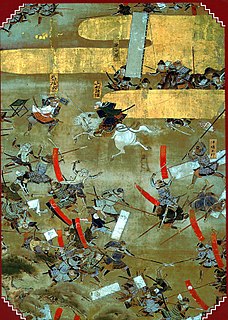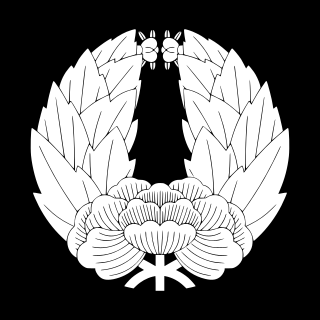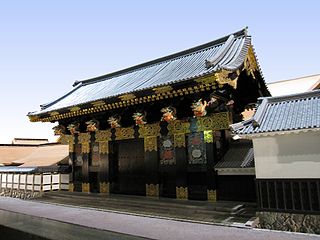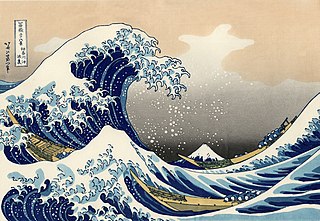
The Shōgun was the military dictator of Japan during the period from 1185 to 1868. The shogunate was their administration or government. In most of this period, the shōguns were the de facto rulers of the country, although nominally they were appointed by the Emperor as a ceremonial formality. The shōguns held almost absolute power over territories through military means. Nevertheless, an unusual situation occurred in the Kamakura period (1199–1333) upon the death of the first shōgun, whereby the Hōjō clan's hereditary titles of shikken (1199–1256) and tokusō (1256–1333) dominated the shogunate as dictatorial positions, collectively known as the Regent Rule (執権政治). The shōguns during this 134-year period met the same fate as the Emperor and were reduced to figurehead status until a coup d'état in 1333, when the shōgun was restored to power in the name of the Emperor.

The Sengoku period is a period in Japanese history marked by social upheaval, political intrigue and near-constant military conflict. Japanese historians named it after the otherwise unrelated Warring States period in China. It was initiated by the Ōnin War, which collapsed the Japanese feudal system under the Ashikaga shogunate, and came to an end when the system was re-established under the Tokugawa shogunate by Tokugawa Ieyasu.

Fudai daimyō (譜代大名) was a class of daimyōs who were hereditary vassals of the Tokugawa in Edo-period Japan. It was primarily the fudai who filled the ranks of the Tokugawa administration.

The Chōshū Domain was a feudal domain of Japan during the Edo period (1603–1867). It occupied the whole of modern-day Yamaguchi Prefecture. The capital city was Hagi. The name Chōshū was shorthand for Nagato Province. The domain played a major role in the Late Tokugawa shogunate. It is also known as the Hagi Domain.

Makino Tadamasa was a Japanese daimyō of the Edo period.
Makino Chikashige was a Japanese daimyō of the early Edo period. He was also known by his title, Sado no kami—Makino Sado no kami Chiashige. He was the son of Makino Takumi no kami Nobushige.

The Nanbu clan was a Japanese samurai clan who ruled most of northeastern Honshū in the Tōhoku region of Japan for over 700 years, from the Kamakura period through the Meiji Restoration of 1868. the Nanbu claimed descent from the Seiwa Genji of Kai Province and were thus related to the Takeda clan. The clan moved its seat from Kai to Mutsu Province in the early Muromachi period, and were confirmed as daimyō of Morioka Domain under the Edo-period Tokugawa shogunate. The domain was in constant conflict with neighboring Hirosaki Domain, whose ruling Tsugaru clan were once Nanbu retainers.

The Tsugaru clan was a Japanese samurai clan who ruled the northwestern half of what is now Aomori Prefecture in the Tōhoku region of Japan under the Edo period Tokugawa shogunate. The Tsugaru were daimyō of Hirosaki Domain and its semi-subsidiary, Kuroishi Domain. The Tsugaru were in constant conflict with their former overlords, the Nanbu clan of adjoining Morioka Domain. During the Boshin War of 1868-69, the Tsugaru clan fought mostly on the pro-imperial side, although it did briefly join the Ōuetsu Reppan Dōmei. In the Meiji period, the former daimyō became part of the kazoku peerage, with Tsugaru Tsuguakira receiving the title of hakushaku (Count). The main Tsugaru line is now extinct.
Makino Sadamichi was a Japanese daimyō of the mid-Edo period.
Makino Hideshige, also known as Makino Hidenari, was a Japanese daimyō of the early Edo period.
Makino Tadakiyo was a Japanese daimyō of the late Edo period.
Fushimi bugyō (伏見奉行) were officials of the Tokugawa shogunate in Edo period Japan. Appointments to this prominent office were usually fudai daimyō, but this was amongst the senior administrative posts open to those who were not daimyō. Conventional interpretations have construed these Japanese titles as "commissioner", "overseer" or "governor".

Emperor Meiji, or Meiji the Great was the 122nd Emperor of Japan according to the traditional order of succession, reigning from 3 February 1867 until his death on 30 July 1912. He presided over the Meiji period, a time of rapid change that witnessed the Empire of Japan rapidly transform from an isolationist feudal state to an industrialized world power.
Ogasawara is a Japanese surname. It may also refer to:

The Kamiyashiki of Matsudaira Tadamasa was a large residential complex that was located outside Edo Castle in 17th century Japan.
Ōkubo Tadatomo was a daimyō in early Edo period, Japan. He was assigned by the Tokugawa shogunate to Karatsu Domain, Sakura Domain, and finally to Odawara Domain in Sagami Province,, where his descendants remained until the Meiji Restoration.

The House of Peers was the upper house of the Imperial Diet as mandated under the Constitution of the Empire of Japan.
Katō Enao was a Japanese waka poet of the mid-Edo period. His real surname was Tachibana (橘), and his original given name was Tamenao (為直); he later changed it to Enao, which he also wrote as 要南甫. His nickname was Matazaemon (又左衛門), and he used various art names including Nanzan (南山), Tokoyoan (常世庵) and Hagizono (芳宜園).













